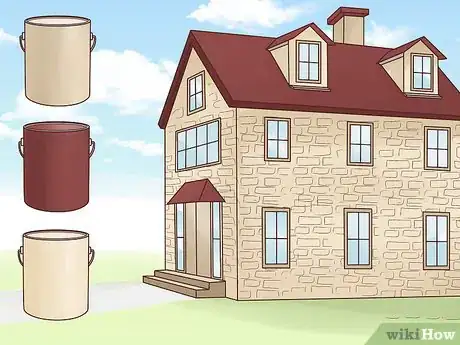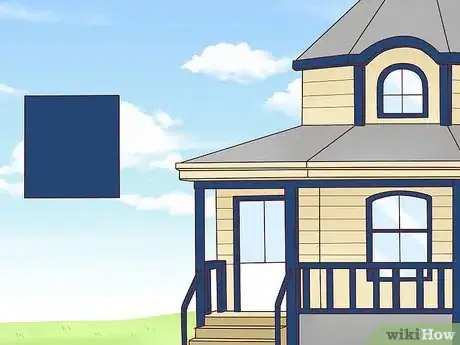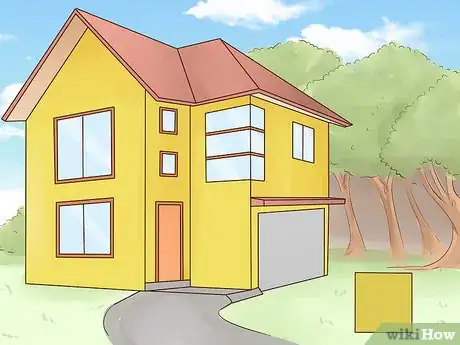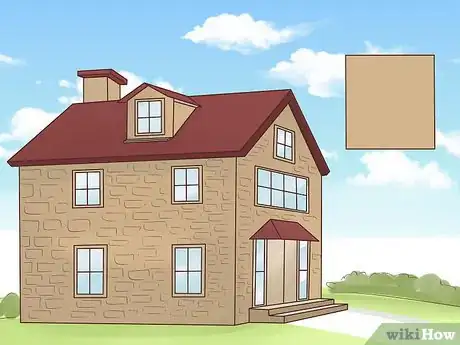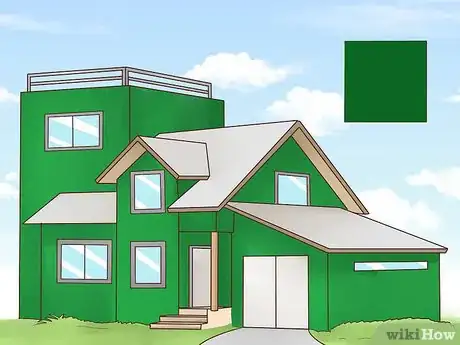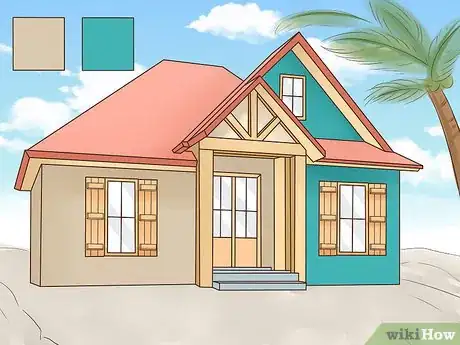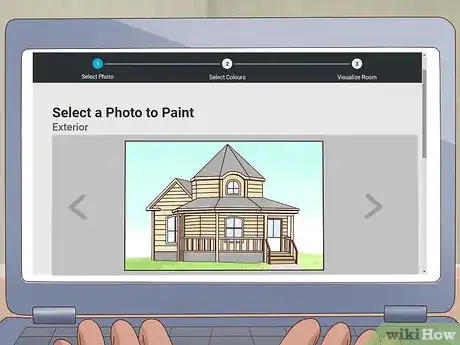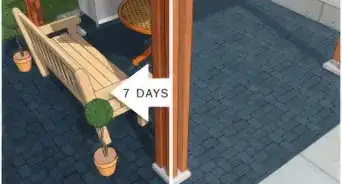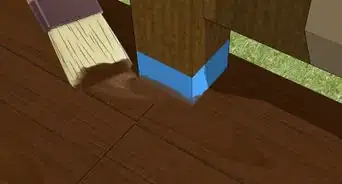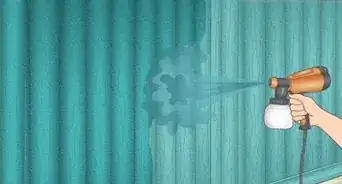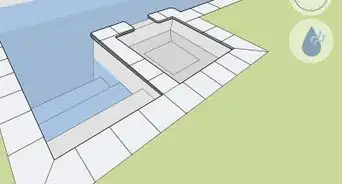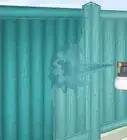This article was co-authored by Jeff Baldwin. Jeff Baldwin is a Residential Painter and the Owner of Baldwin Custom Painting. With two decades of painting experience, Jeff specializes in high-end residential and small commercial painting projects. Dedicated to quality craftsmanship, Jeff and Baldwin Custom Painting provide bonded/insured, licensed, and lead-safe certified services in residential painting, light commercial painting, and wood refinishing.
There are 12 references cited in this article, which can be found at the bottom of the page.
This article has been viewed 32,319 times.
Choosing a paint color for the outside of your home may seem like an overwhelming task. With some planning and consideration, you can easily pick the best colors for your space. Choose 1 main paint color to cover your siding or brick exterior, and go with 1-2 other accenting paint colors to paint things like your shutters and door. You can also use a virtual paint color website to help plan the look of your home.
Steps
Following Basic Design Principles
-
1Choose a style for your house to narrow down your color choices. Before you start to look at paint chips, envision how you want your house to look. Do you want to freshen up a dingy paint job? Add a bright color to liven up your space? Or restore a house’s historical significance? Considering how you want to upgrade your house can help choose your paint colors.[1]
- For instance, if you are revitalizing an old colonial home, go with a classic color palette, like beige, brick-red, and cream.
- If you want to modernize your home, consider going with a bold color like red or navy.
- For a modern style, consider slate-gray, white, or charcoal shades.
- If you want a quaint, inviting style, go with warm colors and earth tones, such as rust, terracotta, or forest green.
-
2Pick 1 color to paint all of the exterior walls with. Rather than picking multiple colors for your siding, pick 1 hue in an attractive shade you enjoy. This way, your house looks polished and neat rather than over-the-top.[2]
- For example, you can choose a light cream shade if you want a classic house color.
- Consider picking a light yellow or blue if you want a bit of color.
- Besides this, you should understand the substrate and the best products for it. For example, you can use only specific paints and colors on a vinyl siding, or they can warp the siding.[3]
Advertisement -
3Choose 1-2 accenting colors for your shutters, door, and trim. In addition to your siding color, you can also choose a couple colors to use to accent the outside of your house. Use 1 color for your shutters, door, and trim for a uniform look, or pick a different color for both your shutters and the door to liven up your space. This adds subtle pops of color, which makes your house look streamlined and unique.[4]
- For example, if you want a classic, timeless look, paint your house light cream and go with a navy blue shutter and door color.
- If you want a personalized look, consider painting the house light yellow, selecting forest green shutters, and coloring the door a bright burgundy hue.[5]
-
4Go with colors that complement the environment around your home. Your landscape and environment can make a difference when choosing your paint shades. Your paint shades will depend on your particular environment. Choose similar shades if you want your home to blend in or choose contrasting colors for a dramatic effect.[6]
- For example, if your home is situated in a forest, go with earth tones in a similar color palette to the leaves and trees if you want your home to blend in. If you want some contrast, you can choose earth tones in a lighter shade, or try blues or yellows instead.
- If you live in the desert, you can choose warm earth tones such as reds and oranges.
- If your house is along the water, choose varying shades of blue, such as sky blue, royal blue, and navy. For a contrasting shade, go with a light yellow or green instead.
- Keep in mind that neutral colors are always a good choice. If you aren't sure of what color looks best for your environment, choose a neutral shade in a similar tone as your environment. Go with a beige, grey, or brown.
-
5Factor in how much natural light your house gets when choosing colors. The color of paint you choose will look slightly different depending on your location. Think about how much light reaches the exterior of your home and consider any artificial lamps or light posts nearby. This can be helpful when selecting particular shades of paint.[7]
- If you live in a house near a lot of trees, the color may look darker once painted on your house. You may want to choose a lighter shade to offset and shadows.
- If you live in a well-lit development, artificial light may make the color look brighter, for example. It may be helpful to select a darker shade to balance the overall look.
-
6Avoid picking a similar house color as your neighbors. If your next-door neighbor has a brown home with light blue shutters, avoid choosing these colors to decorate the outside of your home. Your neighbors may think you are copying them, and your house will not look unique. Instead, choose colors that your current neighbors are not using.[8]
- This mainly applies if you live in a large neighborhood or community. If you live in a secluded area, this does not matter as much.
Picking Color Schemes
-
1Stick with classic neutrals if you plan on selling your home. If you are hoping to add property value to your home, consider using colors such as off-white, gray, taupe, or blue-grey. These colors are, for the most part, universally attractive, so you won’t have any issues selling your home when the time comes. Some buyers may not gravitate towards a bright blue or purple home.[9]
- For instance, go with a beige house and white accents for a classic look.
-
2Go with muted tones of primary colors for a complementary scheme. If you want to add some color to the outside of your space, consider using the primary colors. It is particularly attractive to pick muted shades of red, blue, and yellow. For instance, paint the outside of your home slate-blue, and color your shutters with a light yellow paint. Then, go with a burnt-red door for a subtle color option.[10]
- The bright, true hues can look a bit too elementary if used for your entire exterior.
-
3Choose varying shades of the same hue for a monochromatic option. If you want your house to look simple and attractive, try a monochromatic color palette. You can paint all of the exterior the same color, or go with subtle variations of the same hue. This creates a uniform, neat appearance.[11]
- For example, paint all of your house a white color if you want a very clean-looking exterior.
- You can also choose an off-white base color, vanilla shutters, and a light beige door to slightly vary the hues.
-
4Select a light color scheme if you want your house to look bigger. If you are painting a small home and want to give the illusion of a larger structure, go with light shades! These include white, tan, cream, beige, and taupe, for instance.[12]
- This is a great idea for small colonial homes, for example.
-
5Pick a dark color scheme if you want a dramatic look. Using a dark color scheme can make your house feel smaller, cozier, and grounded. Choose paint hues such as slate-gray, navy, brown, forest green, or espresso.[13]
- This is a great idea if you have a large house with odd proportions and want to balance the space.
-
6Choose a pastel or bright color if you want your home to look whimsical. While a brightly-colored home may not be for everyone, you can surely pick a saturated hue for a personalized paint job. Go with a cypress green, lighthouse red, or brilliant yellow for more traditional colors. Choose turquoise, fuschia, or plum for unique house color options.[14]
- Using bright colors to paint your home can add a cheery, joyful touch to your environment.
-
7Designate 2 bright colors to use as accents to brighten up your house. If you want to incorporate color without painting your entire house a bright color, go with accent colors instead! This is a great way to freshen up an old house, for instance.[15]
- For example, choose a neutral color like beige, and go with a light green and turquoise accents for a tropical style.
- You can also go with a gray house color and paint your shutters bright red for an attractive option. Use the same color to paint your door, or go with a burnt-sienna instead.
Using Paint Color Visualizers
-
1Search online for paint color visualizer websites. Many paint companies offer websites where you can pick different exterior house colors to see what the shade would look like. You can experiment with base color and accent colors before you commit to your paint color.[16]
- Search for “paint color visualizer” or something similar to find different options.
-
2Use a stock exterior photo to get a general sense of color options. Most websites offer images of many types of houses you can use to get a general sense of color options. Select the picture that is closest to the style and architecture of your home, so you can get the most accurate color samples.[17]
- This is a good idea if you don’t want to take and upload a picture of your own house.
-
3Upload a photo of your house exterior to sample specific colors. Once you find a paint color visualizer you want to use, look for the “Upload your own photo” section. Choose the image you want to use, and click “Upload” or “Select.” Then, adjust the exterior paint color settings to experiment with different options. You can change the base color as well as accent colors with most websites.[18]
- Before you do this, you must take and download a picture of your house. Be sure to get a clear shot of the outside. You can take a picture with a digital camera or your smartphone.
-
4Pick your exterior paint color based on which option you like best. Using the visualizer is a helpful aid when deciding what color to paint your home, since you can look at the colors in advance. After you’ve experimented with paint color options, make your decision based on personal preference.
- Take as much time with the visualizer as you need before you make your decision. You don’t need to rush, as picking an exterior house color can be a major decision.
- If you are using a visualizer from a paint company, the program lists the colors of the paint you selected. This way, you can easily purchase the exact hue at a home supply store.
- Remember to use quality products that will last, don't go cheap.[19]
- If possible, use a sprayer. It is the fastest and easiest way to paint your home.[20]
Expert Q&A
-
QuestionHow can I prepare my house for painting?
 Jeff BaldwinJeff Baldwin is a Residential Painter and the Owner of Baldwin Custom Painting. With two decades of painting experience, Jeff specializes in high-end residential and small commercial painting projects. Dedicated to quality craftsmanship, Jeff and Baldwin Custom Painting provide bonded/insured, licensed, and lead-safe certified services in residential painting, light commercial painting, and wood refinishing.
Jeff BaldwinJeff Baldwin is a Residential Painter and the Owner of Baldwin Custom Painting. With two decades of painting experience, Jeff specializes in high-end residential and small commercial painting projects. Dedicated to quality craftsmanship, Jeff and Baldwin Custom Painting provide bonded/insured, licensed, and lead-safe certified services in residential painting, light commercial painting, and wood refinishing.
Residential Painter When you decide to paint your house, have a close look at it. Fix issues such as wood rot, loose boards, and put caulk in areas that need it. Make sure that the surface is clean before painting.
When you decide to paint your house, have a close look at it. Fix issues such as wood rot, loose boards, and put caulk in areas that need it. Make sure that the surface is clean before painting. -
QuestionWhat are the things I should keep in mind while painting my house?
 Jeff BaldwinJeff Baldwin is a Residential Painter and the Owner of Baldwin Custom Painting. With two decades of painting experience, Jeff specializes in high-end residential and small commercial painting projects. Dedicated to quality craftsmanship, Jeff and Baldwin Custom Painting provide bonded/insured, licensed, and lead-safe certified services in residential painting, light commercial painting, and wood refinishing.
Jeff BaldwinJeff Baldwin is a Residential Painter and the Owner of Baldwin Custom Painting. With two decades of painting experience, Jeff specializes in high-end residential and small commercial painting projects. Dedicated to quality craftsmanship, Jeff and Baldwin Custom Painting provide bonded/insured, licensed, and lead-safe certified services in residential painting, light commercial painting, and wood refinishing.
Residential Painter Remember to use quality products that will last, don't go cheap. Understand the substrate and find the products that are suitable for it. For example, if you have vinyl siding, you should use only specific paints and colors, or they will warp it.
Remember to use quality products that will last, don't go cheap. Understand the substrate and find the products that are suitable for it. For example, if you have vinyl siding, you should use only specific paints and colors, or they will warp it. -
QuestionWhich is the fastest way to paint a home?
 Jeff BaldwinJeff Baldwin is a Residential Painter and the Owner of Baldwin Custom Painting. With two decades of painting experience, Jeff specializes in high-end residential and small commercial painting projects. Dedicated to quality craftsmanship, Jeff and Baldwin Custom Painting provide bonded/insured, licensed, and lead-safe certified services in residential painting, light commercial painting, and wood refinishing.
Jeff BaldwinJeff Baldwin is a Residential Painter and the Owner of Baldwin Custom Painting. With two decades of painting experience, Jeff specializes in high-end residential and small commercial painting projects. Dedicated to quality craftsmanship, Jeff and Baldwin Custom Painting provide bonded/insured, licensed, and lead-safe certified services in residential painting, light commercial painting, and wood refinishing.
Residential Painter If possible, use a sprayer because it is the fastest and easiest way to paint your home.
If possible, use a sprayer because it is the fastest and easiest way to paint your home.
Warnings
- Do not attempt to paint your house yourself unless you have a ladder and proper safety equipment. You can fall and get injured easily when painting in high-up spots. Consider hiring a professional painter to paint the exterior of your home.⧼thumbs_response⧽
References
- ↑ https://www.sunset.com/home-garden/design/exterior-paint-colors#home-exterior-color-goal
- ↑ https://www.sunset.com/home-garden/design/exterior-paint-colors#home-exterior-color-goal
- ↑ Jeff Baldwin. Residential Painter. Expert Interview. 1 March 2021.
- ↑ https://www.sunset.com/home-garden/design/exterior-paint-colors#home-exterior-color-goal
- ↑ https://www.southernliving.com/home-garden/decorating/exterior-paint-colors#exterior-paint-palettes-ideas_15
- ↑ https://www.ballarddesigns.com/howtodecorate/2016/04/how-to-pick-exterior-paint-colors/
- ↑ https://www.sunset.com/home-garden/design/exterior-paint-colors#home-exterior-color-goal
- ↑ https://www.sunset.com/home-garden/design/exterior-paint-colors#home-exterior-color-goal
- ↑ https://www.bhg.com/home-improvement/exteriors/curb-appeal/best-exterior-house-color-schemes/?slideId=slide_a6425aa6-4571-4fc0-a24e-656d8d60d2f9#slide_a6425aa6-4571-4fc0-a24e-656d8d60d2f9
- ↑ https://www.bhg.com/home-improvement/exteriors/curb-appeal/best-exterior-house-color-schemes/?slideId=slide_67cfa8a9-207b-4ce4-9610-df6bbf998ee4#slide_67cfa8a9-207b-4ce4-9610-df6bbf998ee4
- ↑ https://www.bhg.com/home-improvement/exteriors/curb-appeal/best-exterior-house-color-schemes/?slideId=slide_b2b258c8-b51a-4d75-8949-ddd81aecf78b#slide_b2b258c8-b51a-4d75-8949-ddd81aecf78b
- ↑ https://www.ballarddesigns.com/howtodecorate/2016/04/how-to-pick-exterior-paint-colors/
- ↑ https://www.ballarddesigns.com/howtodecorate/2016/04/how-to-pick-exterior-paint-colors/
- ↑ https://www.bhg.com/home-improvement/exteriors/curb-appeal/best-exterior-house-color-schemes/?slideId=slide_ff55f715-c561-4b17-a93c-68ac8d168ab6#slide_ff55f715-c561-4b17-a93c-68ac8d168ab6
- ↑ https://www.bhg.com/home-improvement/exteriors/curb-appeal/best-exterior-house-color-schemes/?slideId=slide_47ff3fde-35c3-4fa7-8df1-869b9c963eae#slide_47ff3fde-35c3-4fa7-8df1-869b9c963eae
- ↑ http://www.hgtvhomebysherwinwilliams.com/color-visualizer
- ↑ https://mccormickpaints.chameleonpower.com/#/scene/go
- ↑ http://www.mccormickpaints.com/color-visualizer
- ↑ Jeff Baldwin. Residential Painter. Expert Interview. 1 March 2021.
- ↑ Jeff Baldwin. Residential Painter. Expert Interview. 1 March 2021.
About This Article
While choosing exterior paint for your house can seem like an overwhelming task, you can pick the best colors for your home by following some basic design principles and testing them on a visualizer. Before you buy any paint samples, envision how you want your home to look and think about how the paint will compliment the style. For example, an old colonial home will look great in a classic color palette like beige, brick-red, and cream. Opt for slate-gray, white, or charcoal shades if you have a more modern-looking house. Consider keeping it simple by painting your siding a hue you like and adding a subtle pop of color for the shutters, door, and trim. To see how your ideas look, find a paint color visualizer online and upload a picture of your house so you can virtually test out different color schemes. For more help, like how to choose a color that compliments the environment around your home, read on!
